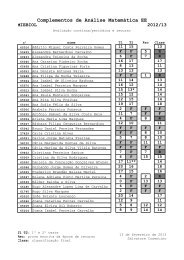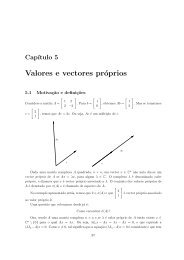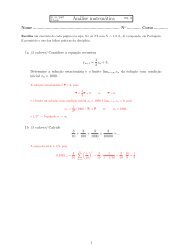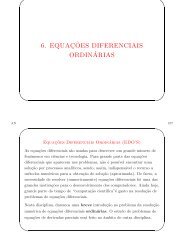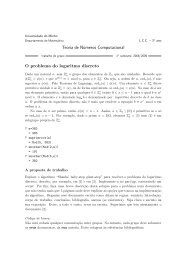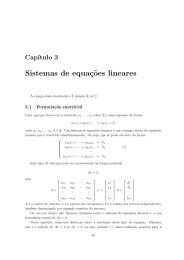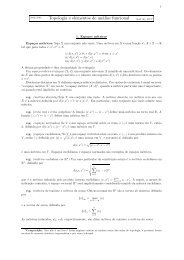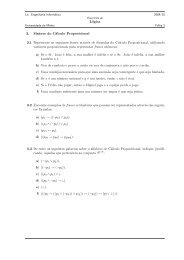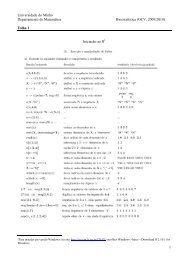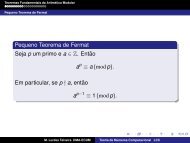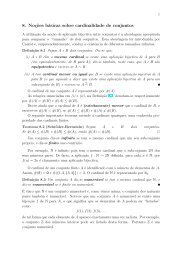My title - Departamento de Matemática da Universidade do Minho
My title - Departamento de Matemática da Universidade do Minho
My title - Departamento de Matemática da Universidade do Minho
You also want an ePaper? Increase the reach of your titles
YUMPU automatically turns print PDFs into web optimized ePapers that Google loves.
11<br />
RECORRÊNCIAS 75<br />
Exercícios.<br />
• Defina uma or<strong>de</strong>m parcial em X <strong>da</strong> seguinte maneira: x ≺ x ′ se para to<strong>da</strong>s vizinhanças U<br />
<strong>de</strong> x e V <strong>de</strong> x ′ existe um tempo n ≥ 1 tal que f n (U) ∩ V ≠ ∅. Prove que x é recorrente sse<br />
x ≺ x.<br />
• Mostre que Per f ⊂ Rec f .<br />
• Dê exemplos que mostram que Rec f e Rec f −1 po<strong>de</strong>m ser vazios.<br />
Pseu<strong>do</strong>-trajetórias e “chain-recurrent points”. Da<strong>do</strong> ε > 0, a sequência <strong>de</strong> pontos<br />
{x k } k=0,1,...,n<br />
com x 0 = x é dita ε-pseu<strong>do</strong>-trajetória <strong>de</strong> x se<br />
d (x k+1 , f (x k )) < ε<br />
para to<strong>do</strong> k = 0, 1, 2, ..., n−1. O ponto x ∈ X é dito chain-recurrent se, para to<strong>do</strong> ε > 0, existe uma<br />
ε-trajetória {x k } k=0,1,...,n<br />
com x 0 = x n = x. Rec ε f<br />
<strong>de</strong>nota o conjunto <strong>do</strong>s pontos chain-recurrent<br />
<strong>de</strong> f.<br />
so what<br />
11.3 Invariant measures and recurrent points: Poincaré theorem<br />
If f satisfies a condition (natural in physics) like ”preserving a probability measure”, then there<br />
are a lot of recurrent points, actually almost any point is recurrent. If, moreover, the probability<br />
measure is diffuse, i.e. any non-empty open set has positive measure, then the set of recurrent<br />
points is also <strong>de</strong>nse. These results, discovered by Jules Henri Poincaré around 1890, motivated the<br />
mo<strong>de</strong>rn theory of dynamical systems. They show how weak informations on the transformation<br />
f may yeld significative qualitative information about ”almost all” orbits of the system. Here<br />
follow the precise statements, together with all the necessary technical <strong>de</strong>tails. If you <strong>do</strong>n’t know<br />
the meaning of some words, like ”measurable” or ”Borel set”, <strong>do</strong>n’t worry, just try to un<strong>de</strong>rstand<br />
what’s going on. Poincaré himself didn’t know, yet!<br />
Poincaré recurrence theorem (probabilistic version). Let f : X → X be an en<strong>do</strong>morphism<br />
of a probability space (X, E, µ), and let A ∈ E. Then the set<br />
A rec = {x ∈ A t.q. f n (x) ∈ i.o. A}<br />
of those points of A whose orbit passes through A infinitely often has total probability, namely<br />
µ (A rec ) = µ (A).<br />
proof. For k ≥ 1, let B k = {x ∈ A s.t. f n (x) /∈ A ∀ n ≥ k} be the set of those points of A<br />
which never return in A after n ≥ k iterates. Observe that B k = A ∩ (∩ n≥k f −n (X\A)), and<br />
that A rec = A\ (∪ k≥1 B k ), and this shows in particular that A rec is measurable. One sees that<br />
f −nk (B k ) ∩ B k = ∅ for any n ≥ 1 (for a point x in the intersection would be a point of B k with<br />
f kn (x) ∈ A for some kn ≥ k), and this implies that f −nk (B k ) ∩ f −mk (B k ) = ∅ for any n > m ≥ 0.<br />
The sets f −nk (B k ) all have the same measure µ (B k ), because µ is invariant, and are pairwise<br />
disjoint. This implies that µ (B k ) = 0, because<br />
∑<br />
µ ( f −nk (B k ) ) = µ ( ∪ n≥1 f −nk (B k ) ) ≤ µ (X) = 1<br />
n≥1<br />
µ (B k )) = ∑ n≥1<br />
and so µ (A rec ) = µ (A). □<br />
Now, let f : X → X be a continuous transformation of a metrizable topological space X, and<br />
let µ be an invariant Borel probability measure. If X admits a countable basis (U i ) i∈N , we can<br />
apply the above theorem to every open set U i . This easily implies that the set of recurrent points<br />
has full measure, i.e.<br />
µ (Rec f ) = 1<br />
In particular, since any set of full measure is <strong>de</strong>nse in the support of a Borel measure, we get the<br />
following general result.



